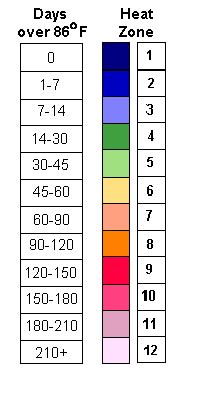Winter Cold
Plant hardiness is generally considered to be the lowest temperature that a plant can withstand during the winter. This is the basis of the US Zone system, widely used by US gardeners to determine whether they can grow a particular plant in their area. The chart below shows winter minimum temperatures in Celsius (Centigrade) and Fahrenheight, and the US Plant Hardiness Zones to which they apply. It also shows the definitions and temperatures used by the RHS (Royal Horticultural Society) and EGF (European Garden Flora).
The RHS zones are: H (Fully Hardy) ~ Hardy to -15oC (5oF); FH (Frost Hardy) ~ Hardy to -5oC (23oF); HH (Half Hardy) ~ Hardy to 0oC (32oF); FT (Frost Tender) ~ Not hardy below 5oC (41oF).
The EGF zones are: H1 ~ Hardy to -20oC (-4oF) and below; H2 ~ Hardy to -15 to-20oC (5 to -4oF); H3 ~ Hardy to -10 to -15oC (14 to 5oF); H4 ~ Hardy to -5 to -10oC (23 to 14oF); H5 ~ Hardy to 0 to 5oC (32 to 40oF); G1 ~ Requires cool greenhouse protection; G2 ~ Requires heated greenhouse protection.

There are far fewer zones in both the European hardiness ratings because most places in Europe where people grow plants fall within US Hardiness Zones 6 to 10.
The fact that plants commonly grown in the higher US Zones do not flourish in the equivalent European Zones indicates that there is more to plant hardiness than an ability to withstand winter temperatures. If that was the only criterion, gardeners in the British Isles would be growing Palms, Oranges and Cannas, and the hedgerows would be covered in Passionflowers and Trumpet Vine. These plants do not thrive in the northern European climate, so there must be other factors which determine where a plant can grow which have a greater influence than the lowest winter temperature it can withstand.
Summer Heat
In much of the US, the Heat Zones follow the usual Hardiness Zones, mainly because of geographical factors. Louisiana is in Hardiness Zones 8 and 9, and also in Heat Zones 8 or 9. In some places, notably around the coast, the Heat Zones are lower than the Hardiness Zones, so that some parts of California, for example, may be in Hardiness Zone 8 or 9 but have a Heat Zone rating of only 3 to 7. Most of the British Isles has a US Hardiness Zone rating of 8 or 9, but a Heat Zone rating of only 1 or 2. Whilst in the US, Heat Zones would be useful to indicate areas where a plant might be at risk from prolonged high temperatures, in Northern Europe, they could be used to indicate where a plant would not have sufficient warmth during the summer to ripen and withstand the winter. This is, indeed, one of the reasons woody climbers and shrubs so popular in the warmer US states do not survive the winter in northern Europe. There are many factors affecting a plant's hardiness, or rather its ability to succeed in any particular place. The type of soil, its ability or inability to release nutrients, or to drain, or to allow roots to penetrate to sufficient depth, can affect plant growth. The level of rainfall, and when it falls, is vital. In the US, drought is a problem in hotter areas in particular. In Northern Europe, it is often not the lack of water but an excess, especially if it is accompanied by cold spells, that affect a plant's survival. Shelter, in a larger area as provided by hills and mountains or more locally by buildings, walls and trees, can affect what can be grown. Towns and cities are usually a few degrees warmer than rural areas. Frosts can be preceeded by snow which provides protective insulation for plants; frost before snow, especially if it is accompanied by drying winds, can damage plants. An overnight frost on a calm night can be harmless; a prolonged frost can prove fatal. Northern and eastern winds, or salt-laden winds from the sea, can be disastrous. Daylength, the angle of the sun and brightness of the light, are as important as the temperature.
Individual plants vary in their ability to accept a particular set of circumstances; every garden provides a different environment. The only way to know if a particular plant is hardy in your garden is to find out all you can about it, provide the conditions it is supposed to prefer, and try it for yourself.
Other Factors
It is now becoming widely recognised that summer temperatures are an important factor affecting where a plant can survive, and a Heat Zone system has been devised based on the number of days an area has when the temperature reaches at least 86oF (30oC). At this temperature, plant cells may be damaged and the plant could be killed.
